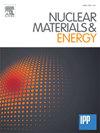双鱼座- rf高通量氘等离子体中复合浓缩合金W38Ta36Cr15V11的首次研究
IF 2.7
2区 物理与天体物理
Q1 NUCLEAR SCIENCE & TECHNOLOGY
引用次数: 0
摘要
在加州大学圣地亚哥分校的Vecchio材料研究实验室,采用火花等离子烧结技术制备了W38Ta36Cr15V11复合浓缩合金(CCA)的大块靶材。通过电子显微镜、能量色散x射线微分析(EDX)、EDX测绘和x射线衍射测量,制备的靶材密度合理,呈BCC相,成分与El-Atwani等人(2019)的靶材接近,并且均匀。在双鱼座- rf高通量线性等离子体装置中,靶体暴露于2×1026 m−2的100ev离子影响下,温度分别为523 K、773 K和1023 K。通过俄歇电子能谱和EDX测定,发现等离子体暴露会产生W和Ta的表面成分富集,这是由表面Cr和V的耗尽引起的,前者通过靶等离子体中的光学发射光谱观察到。伴随着成分的变化,在1023 K暴露的目标上进行等离子体暴露前后的瞬态光栅光谱分析显示,表面热扩散率从9.4×10−6 m2s−1降低到6.7×10−6 m2s−1,降低了约30%。最后,发现D在CCA靶中的保留在~ 900 K时具有单一热释放峰的特征,并且在523-1023 K的温度范围内,保留从2×1023 m−2到3×1020 m−2,通过热解吸光谱测量。与纯钨相比,这种水平的D保留被发现是高的。本文章由计算机程序翻译,如有差异,请以英文原文为准。
A first study of the complex-concentrated-alloy W38Ta36Cr15V11 in Pisces-RF high-flux deuterium plasma
Bulk targets of W38Ta36Cr15V11 complex concentrated alloy (CCA) were produced by spark plasma sintering at the Vecchio materials research lab at the University of California–San Diego. Targets fabricated were reasonably dense, BCC phase, compositionally close in match to that of El-Atwani et al. (2019), and homogeneous, as measured by electron microscopy, energy dispersive x-ray microanalysis (EDX), EDX mapping, and x-ray diffraction. The targets were exposed to deuterium plasma of associated 100 eV ion fluences of m−2 at 523 K, 773 K and 1023 K in the Pisces-RF high-flux linear plasma device. Plasma exposure is found to produce surface compositional enrichment in W and Ta, as determined by Auger electron spectroscopy and EDX, that is caused by a depletion of surface Cr and V, the former being observed with optical emission spectroscopy in the target plasma. Accompanying the compositional change, transient grating spectroscopy analysis, taken pre- and post-plasma exposure on the 1023 K exposed target, revealed reduction in surface thermal diffusivity from m2s−1 to m2s−1. Lastly, D retention in the CCA targets was found to be characterized by a singular thermal release peak at K, and retention varied from m−2 to m−2 for exposure in the temperature range 523–1023 K, as measured by thermal desorption spectrometry. This level of D retention is found to be high relative to pure tungsten.
求助全文
通过发布文献求助,成功后即可免费获取论文全文。
去求助
来源期刊

Nuclear Materials and Energy
Materials Science-Materials Science (miscellaneous)
CiteScore
3.70
自引率
15.40%
发文量
175
审稿时长
20 weeks
期刊介绍:
The open-access journal Nuclear Materials and Energy is devoted to the growing field of research for material application in the production of nuclear energy. Nuclear Materials and Energy publishes original research articles of up to 6 pages in length.
 求助内容:
求助内容: 应助结果提醒方式:
应助结果提醒方式:


